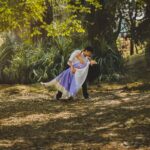It’s a question that’s been asked a few times in our forums over the last few months so while I’m not a Pro Wedding Photographer I thought it was time to share a few tips on the topic of Wedding Photography.
I’ll leave the technical tips of photographing a wedding to the pros – but as someone who has been asked to photograph numerous friends and family weddings – here are a few suggestions.
Understand what the couple want
You need to meet with the bride and groom to be and work out what exactly they want and don’t want so there won’t be any tears when it comes to them seeing the shots from their big day. This is the time when you need to create your contract with them and establish what fee you’ll be charging. Make sure you take a booking fee, this can be non-refundable, and make sure you have the right type of insurance.
Use Two Cameras
Beg, borrow, hire or steal an extra camera for the day – set it up with a different lens. I try to shoot with one wide angle lens (great for candid shots and in tight spaces (particularly before the ceremony in the preparation stage of the day) and one longer lens (it can be handy to have something as large as 200mm if you can get your hands on one – I use a 70-200mm).
Fill Flash
When shooting outside after a ceremony or during the posed shots you’ll probably want to keep your flash attached to give a little fill in flash. I tend to dial it back a little (a stop or two) so that shots are not blown out – but particularly in backlit or midday shooting conditions where there can be a lot of shadow, fill in flash is a must. Read more about using Fill Flash.
Shoot the small details
Photograph rings, backs of dresses, shoes, flowers, table settings, menus etc – these help give the end album an extra dimension. Flick through a wedding magazine in a news stand for a little inspiration.
Plan and prepare
Preparation is key and this statement is very, very true for wedding photography.
If you’ve not shot at the chosen venue before make sure you visit it a few times before the big day. Walk around it, plan a route and look out for areas of the grounds/venue that will be useful to you on the day.
Make sure you have a plan, your equipment out, ready and charged, and if you’re working with a team of people, double-check you all know what you’re doing before the ceremony begins.
Have a chat with the bride and groom so you know every last little detail is ticked of the check-list and create a shooting plan so you have time to get every shot you need.
Shoot in RAW
I know that many readers feel that they don’t have the time for shooting in RAW (due to extra processing) but a wedding is one time that it can be particularly useful as it gives so much more flexibility to manipulate shots after taking them. Weddings can present photographers with tricky lighting which result in the need to manipulate exposure and white balance after the fact – RAW will help with this considerably.
Shot of the bride
Before the ceremony and after party begins, make sure you have at least one great shot of the bride looking perfect in her dress. This will usually be just before she leaves the place where she got ready or just as she arrives at the wedding ceremony venue. That way, if it rains or she does a little bit too much dancing that puts a few creases in her dress it won’t matter!
Be Bold but Not Obtrusive
Timidity won’t get you ‘the shot’ – sometimes you need to be bold to capture a moment. However timing is everything and thinking ahead to get in the right position for key moments are important so as not to disrupt the event. In a ceremony I try to move around at least 4-5 times but try to time this to coincide with songs, sermons or longer readings. During the formal shots be bold, know what you want and ask for it from the couple and their party. You’re driving the show at this point of the day and need to keep things moving.
Be a good director
You need to be confident, give direction without seeming like you’re taking over and be willing to shout ‘look at me’ to the bride, groom or any other subject who’s not looking the right way. Even if you are a little nervous you need to make the wedding party, particularly the bride and groom, feel comfortable and relaxed around you. Make sure you present yourself well, smile and engage in conversation with the people you’re photographing. As a result you’ll gain their trust and respect which will mean you can more easily get on with the job in-hand.







